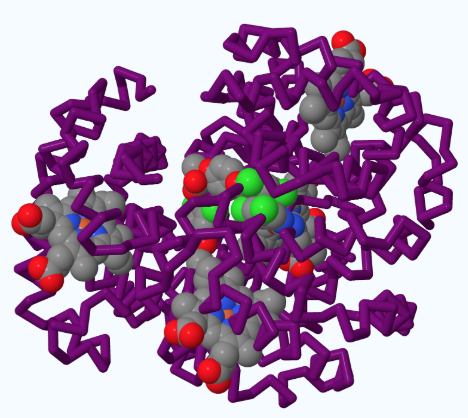“By morning the wind had brought the locusts; they invaded all Egypt and settled down in every area of the country in great numbers...They covered all the ground until it was black. They devoured all that was left after the hail--everything growing in the fields and the fruit on the trees. Nothing green remained on tree or plant in all the land of Egypt.” (Exodus 10:13-15).
The plague of locusts is one of the most striking images from the Old Testament of the Bible. As punishment for Pharaoh’s enslavement of the Israelites, God unleashes a massive swarm of insects upon Egypt, so large that it blocks out the sun. The insects soon ate away all vegetation in the country, plunging Egypt into famine. And though it seems too bizarre and terrifying to be anything more than a biblical story, locusts are still a major threat to 10% of our world population today [1].
A desert locust [5].
Locusts are actually a type of grasshopper. However, out of the 20,000 species of grasshoppers in the world, only 19 of those species are capable of undergoing the locust transformation [2]. They are harmless in small numbers, just like the grasshoppers that you can catch in your own backyard. But when large numbers of these particular species are crowded together, they undergo a fascinating transformation that NPR’s Joe Palca describes on the podcast Short Wave. “...What happens is there’s a change, a physical change in the brain, the wing size, the coloration, that happens because certain species of grasshoppers when you pack them together, literally just pack them together...they turn into this thing that we know as locusts” [2]. Close proximity to other grasshoppers transforms harmless jumping insects into ravenous, destructive beasts, often likened to Dr. Jekyll and Mr. Hyde [2].
Map detailing the areas affected by the desert locust. Swarms (indicated by the red circles) are the most destructive [6].
Currently, a specific species known as the desert locust is a serious problem in the global south, specifically the horn of Africa, a region that includes Ethiopia, Somalia, and Kenya [3]. Recent heavy rainfall in the region has increased locust breeding, resulting in huge swarms of up to 80 million insects per square kilometer that can fly over 100 kilometers every day [1]. In Ethiopia, they devour up to 1.8 million tons of vegetation daily, and are on their way to becoming a plague of biblical proportions [1].
Threat level to crops of the desert locust in affected areas [7].
Because of the enormous threat that locust swarms pose to the food security of those living in the horn of Africa, as well as along the border between India and Pakistan further east, scientists are desperately searching for sustainable control measures. Pesticides aren’t practical: they can be toxic to farmers’ crops and livestock, and the locusts are too widespread to be greatly affected [2]. However, current research in a lab at Arizona State University has suggested that diet might be the key to controlling the plague. Arianne Cease, lead researcher and founder of the Global Locust Initiative, has found that locusts prefer a diet high in carbohydrates (sugars) compared to one high in protein [1,2]. Manipulation of the soil can control the carbohydrate-to-protein ratio in grain crops like millet: healthy soil produces protein-rich grain, while nutrient-poor soil produces grain that is high in carbohydrates [2]. Based on the locusts’ affinity for carbohydrates in a laboratory setting, Cease and her team believe that enriching the soil in affected areas could reduce damage to crops: “If the farmers can be talked into keeping their fields in good shape by fertilizing them and making sure there’s not a lot of runoff...it will be growing a crop that the locusts are less likely to eat” [2].
Is dieting really a feasible solution to the locust plague? The idea must be put to the test in the affected regions before we know for sure. Currently, a trial in Senegal is implementing new fertilization techniques to find out whether a high-protein diet reduces the impact of the Senegalese grasshopper, a locust that is less aggressive than the desert variety [2]. So far, the results look promising: early findings indicate that improving soil fertility can reduce locust numbers by half [1]. Hopefully by better equipping farmers to protect and nourish their land, we can bring the desert locust’s reign of terror to an end, forcing them to endure everyone’s worst nightmare: a strict no-carb diet.
References
Ahuja, A. (2019, December 17). Locust swarms refocus attention on an old enemy. Retrieved February 12, 2020, from Financial Times website: https://www.ft.com/content/32c66414-20be-11ea-b8a1-584213ee7b2b.
Davis, R., Le, V., Sofia, M., & Palca, J. (Producers). (2020, January 22). Can A Low-Carb Diet Prevent A Plague Of Locusts? NPR Short Wave. Podcast retrieved from https://www.npr.org/2020/01/21/798163143/can-a-low-carb-diet-prevent-a-plague-of-locusts.
Food and Agriculture Organization of the United Nations. (2020, February 10). Desert Locust situation update. Retrieved February 12, 2020, from Locust Watch website: http://www.fao.org/ag/locusts/en/info/info/index.html.
Nunn, D. (2014, March 14). Desert locust [Photograph]. Retrieved from https://www.flickr.com/photos/davidnunn.
Kamal, R. (2020, January 22). Desert locust (Schistocerca gregaria) [Photograph]. Retrieved from https://www.npr.org/2020/01/21/798163143/can-a-low-carb-diet-prevent-a-plague-of-locusts.
Current desert locust situation [Image]. (2020, February 10). Retrieved from http://www.fao.org/ag/locusts/en/info/info/index.html.
Situation & threat of desert locust [Image]. (2020, February 10). Retrieved from http://www.fao.org/ag/locusts/en/info/info/index.html.



![A desert locust [5].](https://images.squarespace-cdn.com/content/v1/558bc22ce4b0574c94d31c79/1583034726601-0YCUA5QXC8Q1MHO22JO8/locust.jpg)
![Map detailing the areas affected by the desert locust. Swarms (indicated by the red circles) are the most destructive [6].](https://images.squarespace-cdn.com/content/v1/558bc22ce4b0574c94d31c79/1583034552067-8A4XFFTFS5R4VQZOYFO8/map+detailing.jpg)
![Threat level to crops of the desert locust in affected areas [7].](https://images.squarespace-cdn.com/content/v1/558bc22ce4b0574c94d31c79/1583034649584-6OZYS794Q341JQOIV9Q4/threat+level+to+crops.jpg)


![Photo of Poe taken in 1849, original and colorized, showing slight slanting of the eyes and mouth that is indicative of chronic CO exposure [6].](https://images.squarespace-cdn.com/content/v1/558bc22ce4b0574c94d31c79/1575844230598-R3XHDUY5OQE7SJ7EKBH6/Screen+Shot+2019-12-08+at+4.30.16+PM.png)



